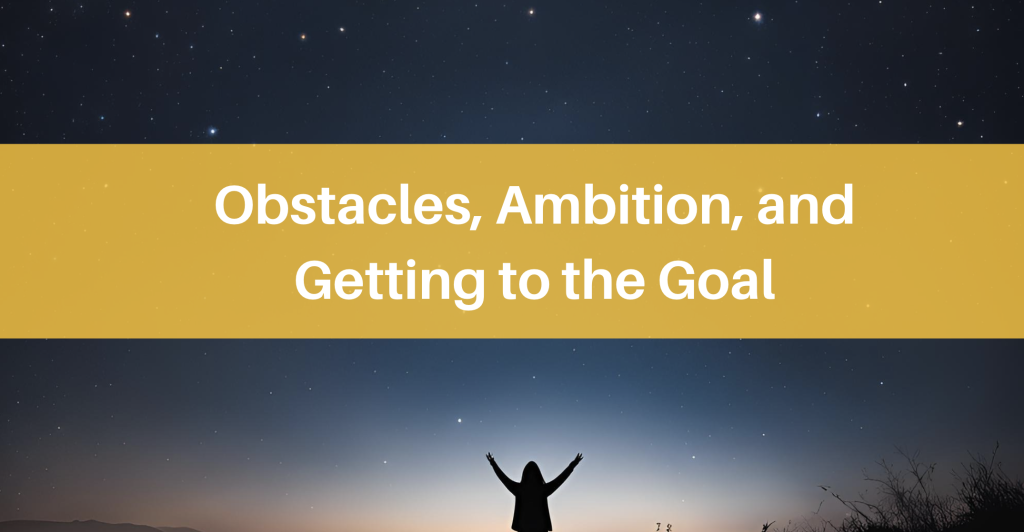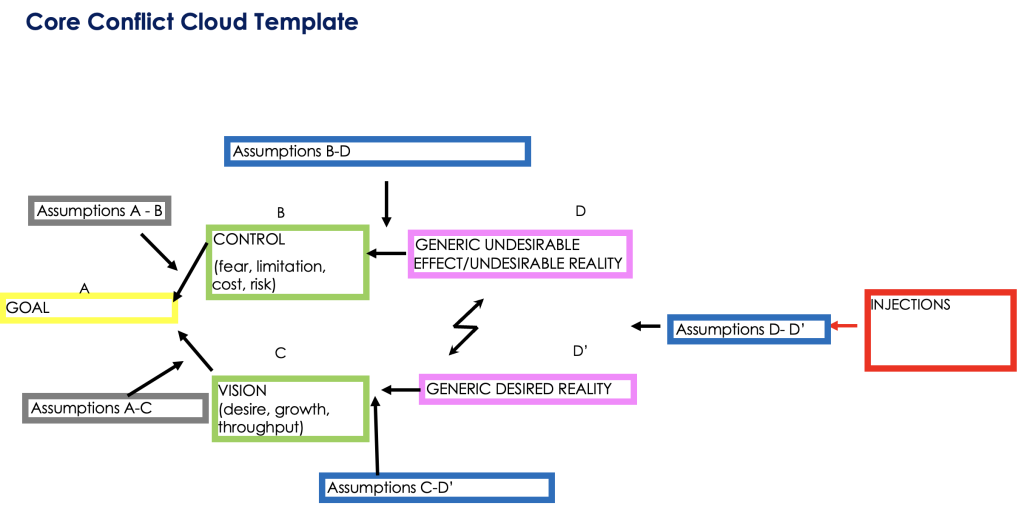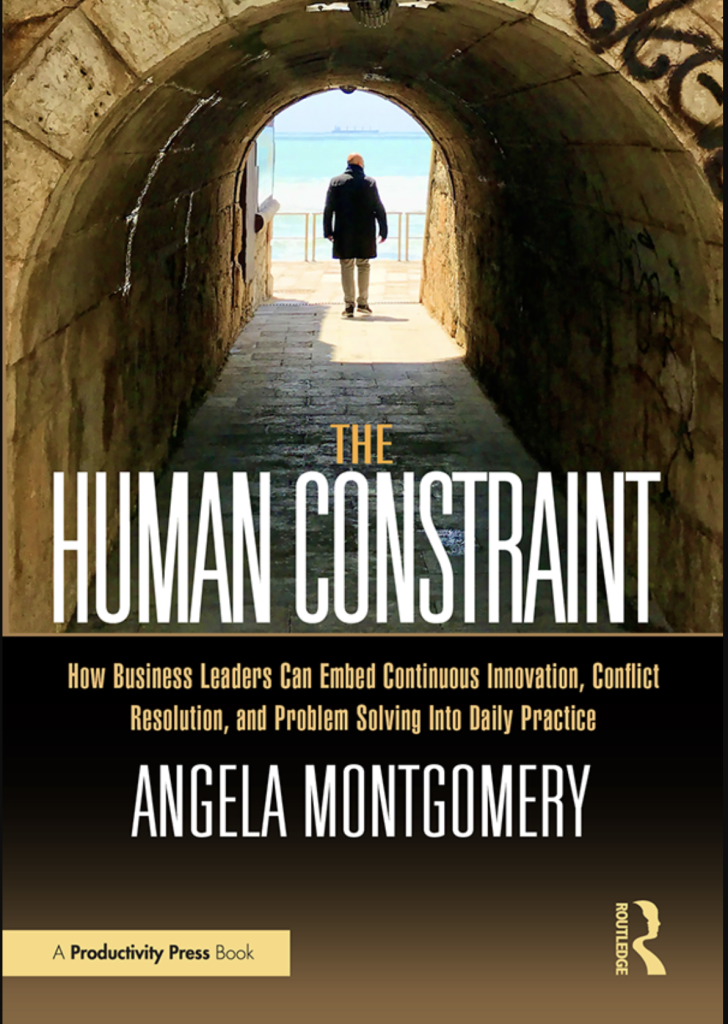
What is an obstacle? Something that is in the way and prevents us from going forward in a direction we have chosen. If obstacles are something negative, then we can quickly become discouraged. They may even become an excuse for not even trying.
What if we flip the script? What if, instead of letting obstacles block us, we “use” obstacles to build the path towards an ambitious goal?

The image above illustrates precisely what we can achieve with the Prerequisite Tree, a systemic Thinking Process from the Theory of Constraints. Once we have set a goal, especially an ambitious one, we can build a Prerequisite Tree. This is valid for a goal for which we, as individuals or as a team, have some intuition and knowledge about (not, e.g., how do I become a baseball player if I am five feet tall.) The Prerequisite Tree gathers our knowledge and intuition about a carefully verbalized goal into something we can use. It guides us to verbalize obstacles and then transform them into Intermediate Objectives that become our path. It leads us to think about the all-important sequence of the Intermediate Objectives based on “prerequisites”. What, necessarily, has to come first? What can be done in parallel? And so on, until we reach the goal. It provides us with the backbone of any project.
How on earth are we going to do this?
Cognitively and emotionally, the Prerequisite Tree shifts us from a sense of “How on earth are we going to do this?” to “This is the way we are going to do this.” Investing time in building a Prerequisite Tree instead of launching into a “to do” list can be one of the most satisfying and hope-providing activities we can do. It will provide the necessary focus and direction to harness our physical, mental and emotional energies effectively towards achieving an identified goal. The Thinking Processes are not just about logic. As humans, thinking is always accompanied by emotions. When we use the Thinking Processes regularly, they will increase our systemic intelligence and help us to develop what we at Intelligent Management like to call “intelligent emotions”. For more than two decades, we have helped dozens of organizations build hundreds of Prerequisite Trees and we know how powerful they can be as a method for change.
Ambition to get to the goal
Obstacles blocking the path towards a goal can become the path itself. However, whatever our goals and vision are for the future, in order to actualize them we need drive, tenacity and ambition.
In a recent article, a prominent entrepreneur bemoans a lack of ambition in Canadian companies that leads start-ups to be acquired rather than establish themselves. A lack of willingness to take risks creates a culture of followers rather than pioneers and leaders. It breeds complacency. “Blind ambition”, on the other hand, doesn’t see (or care about) the damage it causes in its relentless pursuit of a goal.
There can be something different from risk-averse complacency versus blind ambition. What about a different kind of ambition, one that sees that in achieving a goal, there are benefits for multiple stakeholders?
A new generation of entrepreneurs has the opportunity to tap into a different kind of thinking about ambition. There is an alternative to repeating the errors of the past that create “successful” businesses that do harm, both to those that work for them and the society they impact.
Building a breakthrough solution towards an ambitious goal
Whenever we at Intelligent Management work with an organization, we guide them to build their Core Conflict. This is a Thinking Process from the Theory of Constraints that leads organizations to a profound understanding of where and why they are stuck and how to challenge their assumptions (mental models) to create a breakthrough solution towards an ambitious goal. It helps us tap into a higher, systemic intelligence where we situate our legitimate ambitions within a bigger picture, understanding that any business is part of a network of interdependencies. A robust, systemic solution will benefit the entire network. This is the only kind of solution that is sustainable over time. It requires an understanding that success in the long-term is based on a vision of unity and not divisiveness.

Ambition is necessary for us to evolve as businesses and societies. By unveiling how we are all interconnected through systemic thinking, we can create solutions that enrich and empower us on many levels and not just financially in the short-term.
The Thinking Processes feature in the new business novel ‘The Human Constraint: How Business Leaders Can Embed Continuous Innovation, Conflict Resolution and Problem Solving Into Daily Practice ’, Routledge, 2024: https://bit.ly/4dwaqRc

To find out more about ten guided steps to a systemic leap ahead for your company, contact Angela Montgomery at intelligentmanagement@sechel.ws
SCHEDULE AN INTRODUCTORY CALL WITH US

Intelligent Management works with decision makers with the authority and responsibility to make meaningful change to optimize your company for the digital age. We have helped dozens of organizations to adopt a systemic approach to manage complexity and radically improve performance and growth for over 25 years through our Decalogue management methodology. The Network of Projects organization design we developed is supported by our Ess3ntial software for multi-project finite scheduling based on the Critical Chain algorithm.
See our latest books: The Human Constraint from Taylor & Francis; From Silos to Networks: A New Kind of Science for Management from Springer; Moving the Chains: An Operational Solution for Embracing Complexity in the Digital Age by our Founder Dr. Domenico Lepore, and ‘Quality, Involvement, Flow: The Systemic Organization’ from CRC Press, New York by Dr. Domenico Lepore, Dr. Angela Montgomery and Dr. Giovanni Siepe.





Leave a Reply